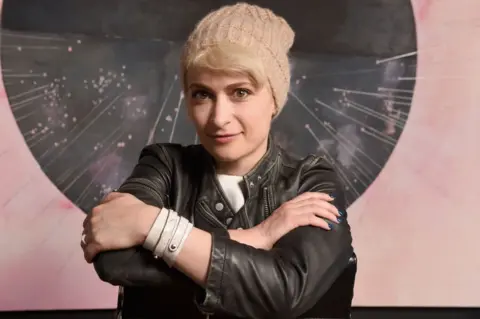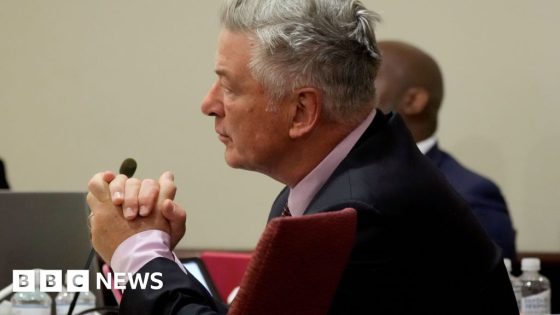By Christal Hayes, Samantha Granville and Emma Vardy, BBC News
Alec Baldwin’s trial opened in New Mexico on Wednesday with the prosecution and defence painting starkly different pictures of the events leading up to the death of cinematographer Halyna Hutchins.
Mr Baldwin, known for roles on the sitcom 30 Rock and portraying Donald Trump on Saturday Night Live, is facing up to 18 years in prison if convicted of involuntary manslaughter.
Ms Hutchins, 42, died after a gun Mr Baldwin was rehearsing with went off. It was found that the film’s armourer, Hannah Gutierrez-Reed, accidentally mixed up dummy bullets with live ammunition she had brought from home.
Mr Baldwin has pleaded not guilty and maintains he never pulled the trigger when the gun went off.
In their opening statements, the defence portrayed Mr Baldwin as an actor simply doing his job, who placed his trust in a crew charged with ensuring weapon safety.
Prosecutors argued he was a man with a flagrant disregard for gun safety on a film set with a small budget and an inexperienced cast.
Prosecutor Erlinda Johnson opened the trial by telling the jury that the case was “simple” and “straightforward”.
Mr Baldwin “played make-believe with a real gun” and “violated the cardinal rules of firearms safety”, Ms Johnson argued.
“While it was a movie set, it was a real, live workplace for many people,” she said in her opening statements. “You will hear that this workplace was on a tight budget… and some of the people who were hired were inexperienced.”
Mr Baldwin’s defence team, however, argued firearms are treated differently on a film set, where each member of a cast has a designated role and obligation, including when it comes to safety and firearms.
“He was just acting as he’s done for generations, and it was the safety apparatus that failed them all,” Baldwin’s lawyer Alex Spiro said.
“Alec Baldwin committed no crime,” he said firmly, later adding: “It was an actor handling a prop.”
Those crew members responsible for safety – including Gutierrez-Reed and David Halls, an assistant director and safety co-ordinator – failed their jobs, he argued.
“Real bullets are never supposed to be on movie sets,” Mr Spiro said.
 Getty Images
Getty ImagesBoth Halls and Gutierrez-Reed faced charges in the fatal shooting.
Halls has pleaded guilty to unsafe handling of a firearm and Gutierrez-Reed was found guilty of involuntary manslaughter earlier this year, and sentenced to 18 months in prison.
A key issue during the trial is Mr Baldwin’s claim that he did not pull the trigger when the revolver he was holding went off.
Prosecutors took aim at the claim early, detailing the extensive FBI tests done on the weapon.
It “worked perfectly fine as it was designed,” Ms Johnson told the jury.
Mr Baldwin’s team also brought up the tests and noted that during one of them, the FBI destroyed parts of the weapon – thus preventing it from being used for further analysis as part of their defence.
The rest of the trial will feature several witnesses and video and audio from the Rust set, including from the day Ms Hutchins was killed.
The first witness called on Wednesday was Officer Nicholas LeFleur, who responded to the scene and tried to aid Hutchins after she was shot.
Footage from his body camera was shown in court.
The room, which can hold about 100 people, was filled with heavy sighs as they watched some of Ms Hutchins’ last moments.
Mr Baldwin was visibly uncomfortable, leaning back and forth and at some times grimacing and covering his face.
The trial is set to continue until 19 July. Baldwin faces up to 18 months in prison.
Source Agencies


